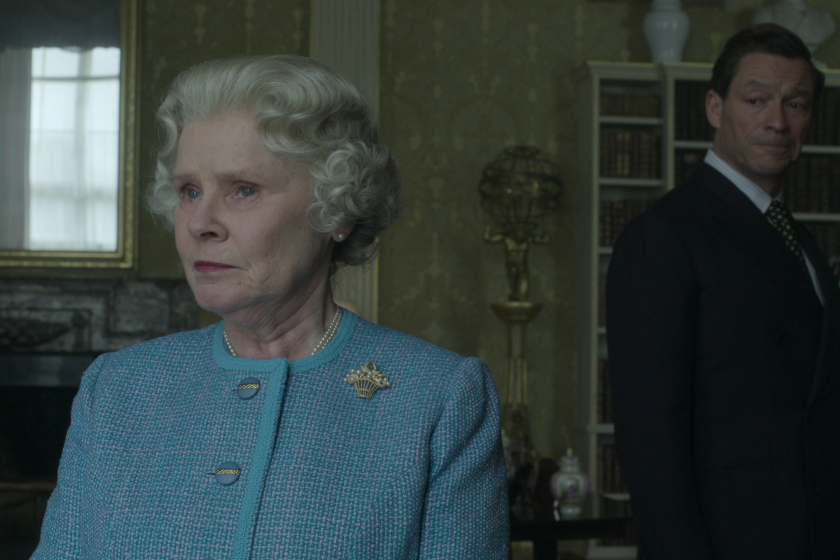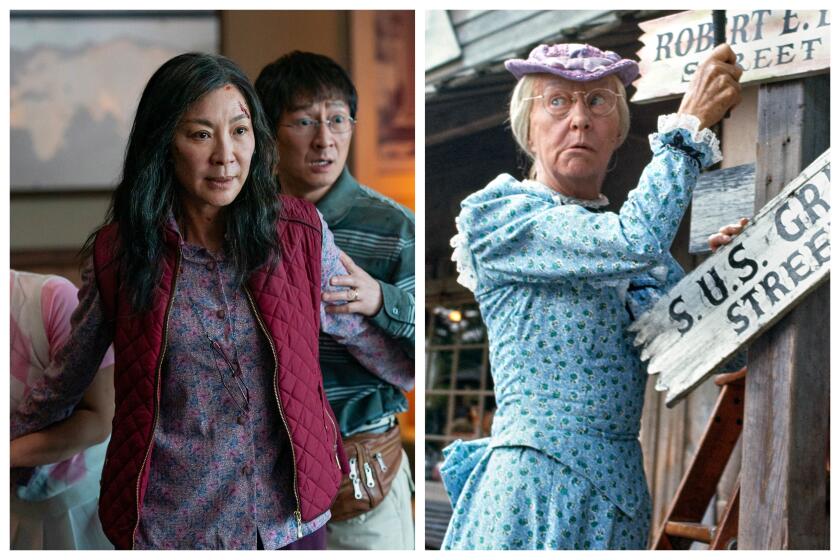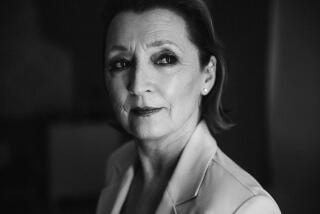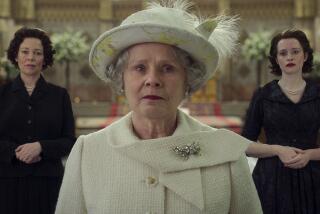Column: ‘The Crown’ was Netflix’s crown jewel. Then it pushed Queen Elizabeth II aside
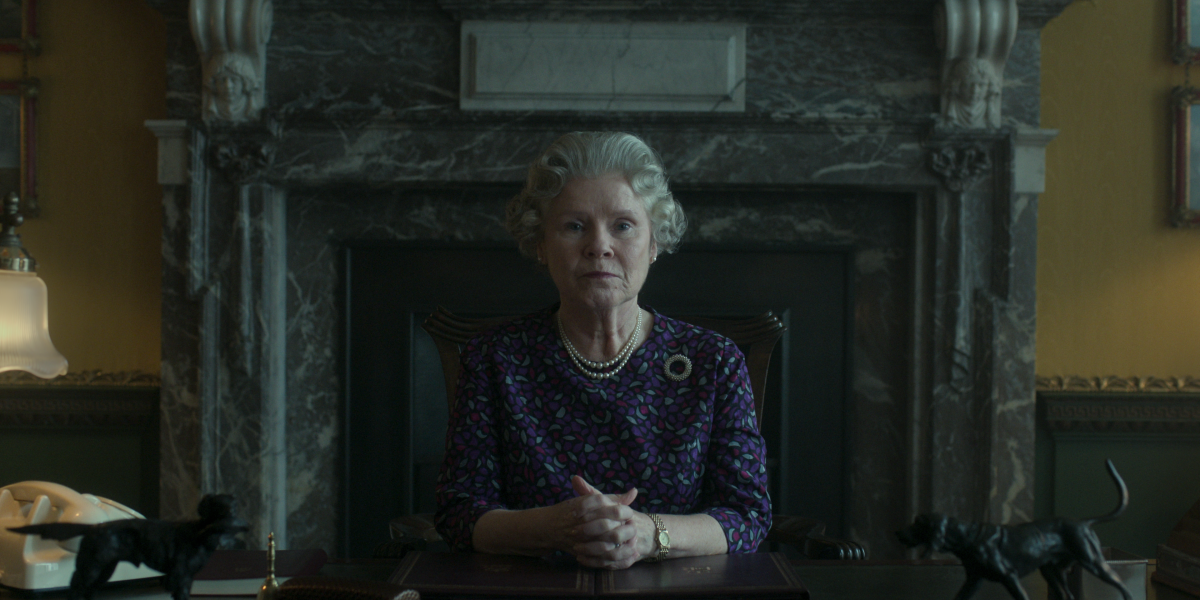
In the last few minutes of the “The Crown’s” Season 4 finale, Prince Philip (Tobias Menzies) attempts to connect with and comfort the increasingly isolated and unhappy Princess Diana (Emma Corrin). When she responds in too-little-too-late frustration and threatens to “break away,” Philip reminds her what the royal family, and indeed “The Crown,” is all about — the queen.
“Everyone in this system is a lost, lonely, irrelevant outsider,” he tells her, “apart from the one person, the only person, that matters. She’s the oxygen we all breathe, the essence of all our duty. Your problem, if I may say, is you seem to be confused about who that person is.”
Diana, as it turns out, was not the only one. Which may be one reason why, as it arrives at its grand finale Thursday, “The Crown” cannot claim the glory, or the audience, it once had.
Although the series has regularly devoted episodes to those who surround the queen — including Philip, Princess Margaret, Prince Charles and Princess Anne — its focus consistently remained on Queen Elizabeth II, played in the first two seasons by Claire Foy and the next two by Olivia Colman.
Until, alas, the final two seasons. With the words he gave Philip still ringing in his ears, creator Peter Morgan proceeded to relegate the “essence of all our duty” increasingly to the back pew; by the first half of the sixth and final season, which premiered last month, Imelda Staunton’s Elizabeth II was lucky to get a word in edgewise.
Instead, “The Crown” became a nonstop, and surprisingly controversial, Wales watch.
Part 2 of the Season 6 is out now. Here’s what you need to know about the Netflix series that centers on the British royal family, including Prince Charles, Camilla, Queen Elizabeth, Prince Harry, Prince William, Kate Middleton and more.
Existentially, it makes some sense. One of the biggest narrative tensions has long been the relevance of the monarchy — Season 5 opened with an episode in which much is made of the media’s suggestion that the U.K. has grown tired of its queen, who is said to be suffering from “Queen Victoria syndrome,” in reference to her 19th-century predecessor’s 63-year reign.
As if to prove the media correct, the series shifted its gaze to the oft-chronicled troubles of Diana (Elizabeth Debicki), Charles (Dominic West) and Camilla (Olivia Williams).
At the start of Season 6, even Dodi (Khalid Abdalla) and Mohamed Fayed (Salim Daw) seemed to have more screen time than the “oxygen we all breathe,” who was too often squeezed in as a reactionary footnote — nodding or frowning over the breakfast table or offering brief commentary as she heads off to cut the ribbon at yet another boot factory .
The final five episodes initially follow the trend, devoting their stories to Prince William‘s (Ed McVey) courtship of Kate Middleton (Meg Bellamy), with a few glancing mentions of “poor” Prince Harry (Luther Ford).
Morgan’s narrative choices in seasons 5 and 6 may reflect the cultural gaze of the time, but it has greatly diminished the series in the process. What once reigned supreme as perhaps the final offering of TV’s Golden Age, and as Netflix’s grand entry into period prestige, has dwindled to a soap-operatic rehash of scandal and tragedy that includes, one must regretfully observe, an excruciating, minute-by-minute account of Diana’s last day on this earth
Not exactly a story that has never been told.
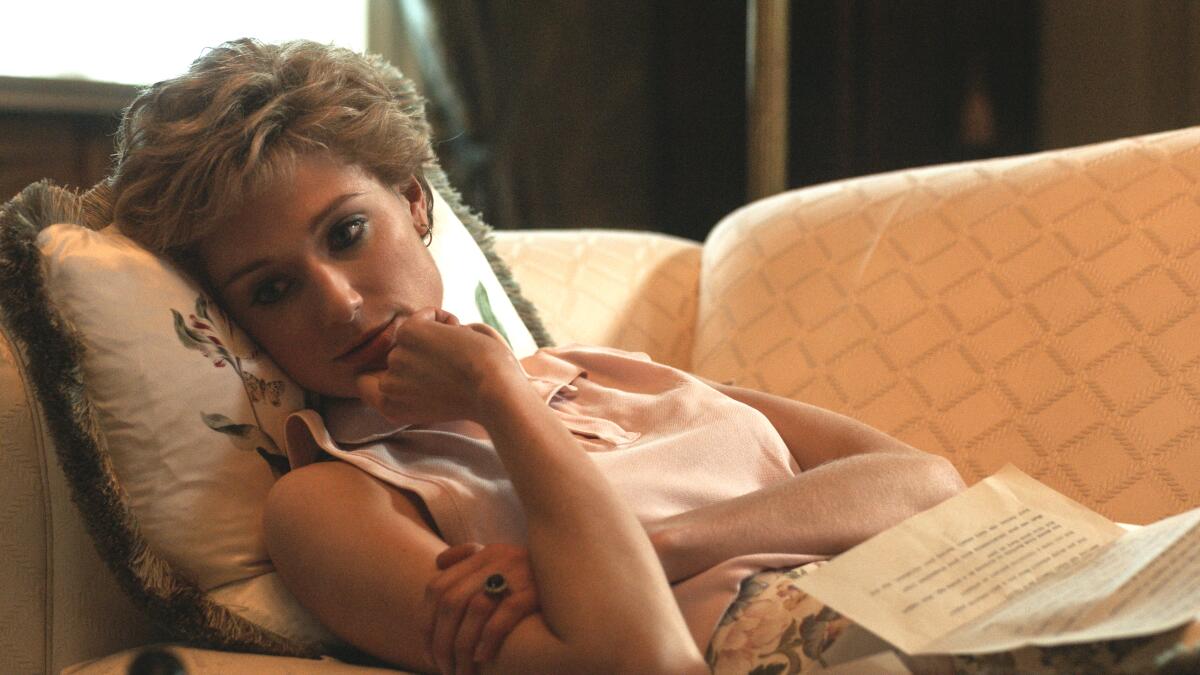
Obviously, no tale of Queen Elizabeth II could possibly gloss over the tragedy of Diana’s death or the profound effect the “people’s princess” had on the monarchy, Britain and the world, any more than it could ignore the deleterious psychological effect that the prospect of succession has had on Charles, now king, and William. As a title, “The Crown” refers as much to the institution as the person.
But even if the goal is to chronicle the eclipsing of the queen by younger royals or simply by time, it is difficult for any series to survive the sidelining of its main character. Especially when she is the longest-reigning monarch in British history, played by a powerhouse like Staunton.
The outpouring of grief over her death last year proved that Elizabeth II remained a fixed point in the hearts of millions, including fans of “The Crown,” who, no matter what they might feel about the actual monarchy, watched the queen cope with the trials and tribulations of her strangely confined but undeniable influence for years.
The power of the series’ early seasons emanated directly from Elizabeth and the astonishing performances each actor was allowed to give. We watched rapt as the queen navigated all manner of churning waters — familial, national and international — all while trying to keep some part of her own identity from being crushed by the weight of expectation, tradition and protocol.
In Season 6, “the only person that matters” has too often been reduced to the role of “granny.”
Which is sweet, in a way, but also quite ageist. Are we to suppose that the British monarch had nothing on her plate that did not involve Diana? That she became less interesting as a main character as she grew older and a bit fatter? That her long-enduring marriage to Philip (Jonathan Pryce) or the inner and outer conflicts of a post-menopausal woman won’t hold the viewers’ attention as easily as the more headline-grabbing issues of the younger generation?
A generation ago, 60 was a milestone many women would not admit to, for good reason. Now it’s just another year in a life.
As the storylines have become more current, they have, perhaps inevitably, become both slighter and messier. Moving out of the realm of the historical and into the realm of contemporary drama, the writers have less scholarship and more tabloid fodder — Churchill is long gone, and any potential plots about national secrets would no doubt still be classified.
Instead, we are left with “post-Diana” as a leitmotif, and there are only so many ways in which William can be allowed to express his depression by moodily staring out the window or into his beer (though Morgan certainly uses them all).
Regrettably, Princess Anne (Claudia Harrison) is also missing from most of Season 6, despite being the royal most worthy of a spin-off . Lesley Manville’s Princess Margaret is also in short supply, though Margaret does dominate an exquisite episode as the series comes to a close.
As does Elizabeth. Far too much of the final season’s second half is devoted to William — his grief, his discomfort with growing public adoration and, of course, his relationship with Kate — but as the series nears its end, it fixes its eyes once again on the woman who wears “The Crown.”
Staunton, when given even the smallest bit of room, comes shining through. In scenes small and large, she radiates both the humor and the dignity of her majesty in later years and the woman’s own increased isolation as she outlasts and outlives so many of the people closest to her.
In each of the powerful scenes Elizabeth is granted, we see breathtaking glimmers of early seasons and a reminder that in telling the story of “The Crown,” it is never the wisest move to sacrifice your queen.
More to Read
The complete guide to home viewing
Get Screen Gab for everything about the TV shows and streaming movies everyone’s talking about.
You may occasionally receive promotional content from the Los Angeles Times.
